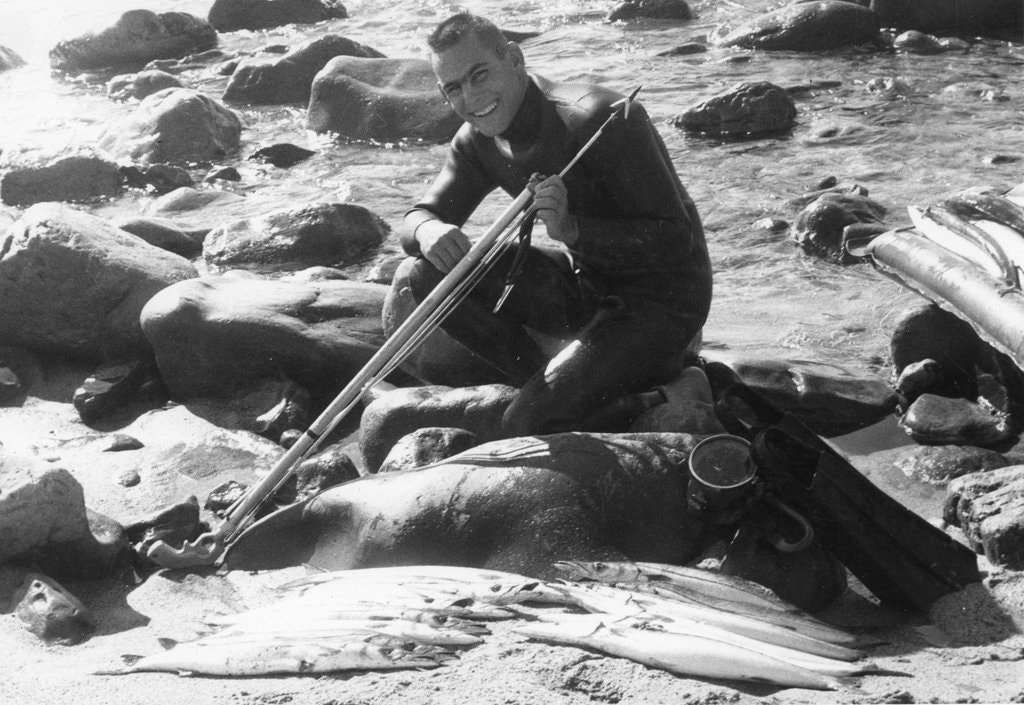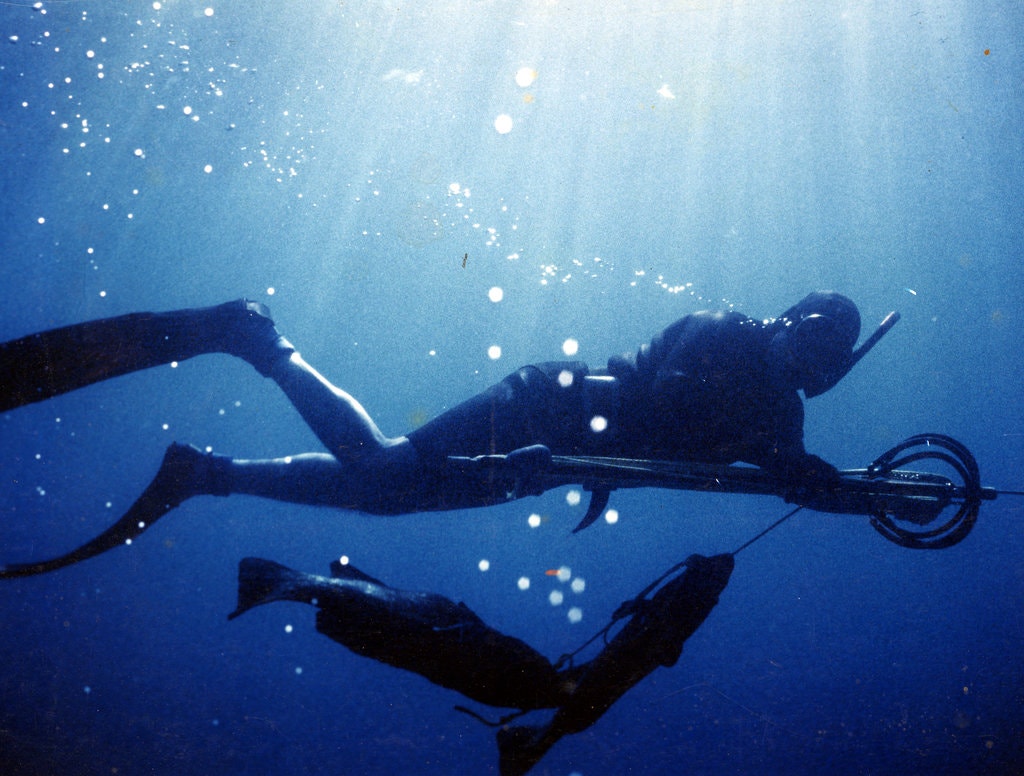https://www.nytimes.com/2020/0…g-king-is-dead-at-82.html
Jay Riffe, Spearfishing King, Is Dead at 82
He became a champion in sport fishing while in his 20s and went on to found a leading company in the manufacture of spearfishing and diving gear.

Jay Riffe in the late 1950s. He said took up spearfishing with his older brothers just “to get food for the table.”Credit...via Riffe family
By Tom Mashberg
• July 14, 2020
Jay Riffe recalled his first spearfishing outing as a fearsome affair — not for the fish but for him. Mr. Riffe, a celebrated California speargun designer, entrepreneur and pioneer of tankless hunting and diving, was about 10 years old, stalking lobster and sea bass in 70-degree Pacific waters while wearing a sweatshirt, gardening gloves and boxer trunks.
“When you came out,” he recalled of his early forays as a sport fisherman in a 2015 interview with the podcast “The Spear,” his body would be bruised and battered “from being rolled in the surf and the rocks and the sea urchins.”
He added, “But no one ever complained because this was the sport — this was the thrill.”
When he died on May 11 at 82, at his home in Dana Point, Calif. — a death not widely reported beyond spearfishing circles — Mr. Riffe left behind a trail of accomplishments in his undersea world, including breaking three world records for deepwater sport fishing; founding Riffe International, a premier American spearfishing and freediving equipment maker; and advancing a campaign for sustainable-fishing regulations. His family said the cause was heart failure.
A powerfully built freediver who could hold his breath for five minutes or more while chasing after tuna, grouper and dorado at depths of up to 100 feet, Mr. Riffe (pronounced rife) first took up spearfishing with his older brother John for a simple reason — “to get food for the table,” as he put it.
By age 22 he was the Pacific Coast spearfishing champion
“Back then the water was so clear, you could see down forever,” he once recalled, adding that the abundance of fish off Palos Verdes and Laguna Beach was far greater than it is today. “So spearfishing started to spread by word of mouth,” he said, and hunters were looking for guns that were easier to hoist and did not “go off like a spring-loaded bazooka.”
For nearly 50 years, beginning in the late 1960s, Mr. Riffe built and developed spearguns and other devices that revolutionized the sport in the United States. His company used supple woods, like teak, which could be grooved to fit a spear shaft snugly; corrosion-resistant magnets, which kept spear tips from wobbling; and textured nylon grips, which kept guns from slipping from the spearfisher’s hand.
“He was a gentle giant, and he had a passion for engineering the perfect speargun for the world,” said his wife, Jackie Riffe, who co-founded Riffe International. Along the way, she said, her husband boated and hunted with the likes of Desi Arnaz Jr., Bing Crosby, Jacques Cousteau and Buzz Aldrin. “Everybody wanted to hear Jay Riffe’s stories,” she said. “He was known all over the world.”
Jesse Taylor Riffe Jr. was born on Feb. 23, 1938, the son of Jesse Sr. and Eva May (Mortimer) Riffe. He started his diving career at age 8 as a “caddy” for his eldest brother, John: John would dive down to grab lobsters and abalone and Jesse Jr., who came to be known as Jay, would swim above and collect the catch in a rucksack.
John would go on to become a Navy frogman while Jay worked as a lifeguard, married Jackie Pierson and moved to Australia in 1973 to help start up the DoALL Co., a maker of industrial machinery.
He returned to California a year later to set up DoALL’s American operations and to help raise his two daughters, Julie and Jill. Budgets were tight, his daughter Jill Riffe Salerno said.
“He was really stressing out to make ends meet, and part of that was catching fish for dinner,” she said. “He had this wood bench in the garage where he would filet everything — yellow tail, dorado, white sea bass, calico bass, lobsters — and we would go camping and fishing along the beaches in Mexico too.”
Mr. Riffe soon realized that the spearguns prevalent on the West Coast were unwieldy and inaccurate. An inveterate tinkerer, he set up a shop in his garage in Dana Point, south of Los Angeles in Orange County, and began perfecting what became the Riffe line, led by a gun called the Marauder. (The smaller Riffe Euro gun will be featured in a forthcoming James Bond movie, “No Time to Die.”)
Before long Mr. Riffe’s garage became a focal point for “spearos,” and demand for his handmade guns grew. Soon he had a small plant and warehouse as well as hunting buddies and customers like Mr. Arnaz and Mr. Cousteau. Today, Riffe International makes all of its spearfishing equipment a few miles down the road in San Clemente.
“He dove with many influential people,” Jill Riffe said. “Plane tickets would arrive from the Middle East and Europe because they all wanted to dive with Jay Riffe.”

Mr. Riffe in his element. He was an advocate for sustainable-fishing regulations. “We have to fish so that future generations can enjoy the sport,” he would say.Credit...Tony Smith
Mr. Riffe broke three world records for sport fishing in the 1970s, catching a 62-pound wahoo, a 44-pound dorado and a 286-pound yellowfin tuna. “That tuna, he wanted to take me out to sea,” Mr. Riffe recalled. He hung onto a float until the tuna tired, then descended to apply the coup de grâce.
Mr. Riffe was instrumental in altering sportfishing rules so that hunters would be required to submit one catch per contest, rather than accumulate as many fish as possible to win by overall weight.
“Dad always said, ‘We have to fish so that future generations can enjoy the sport,’” Jill Riffe said. “He didn’t want people to abuse the power and overtake or deplete the stock. He was very firm about keeping it selective and sustainable.”
She said he had encouraged freedivers to harvest just what they needed. “Conservation was his philosophy,” she said
In addition to his wife and daughter Jill, Mr. Riffe is survived by his daughter Julie and several grandchildren. The family plans to hold a memorial service in August.
Like all great fishermen, Mr. Riffe had his share of harrowing undersea encounters, including coming jaw to jaw with a great white shark (no blood drawn by either side), and finding himself among a swarm of hammerheads off Costa Rica while teaching the sport to his daughter Julie, herself a highly accomplished spearo.
“She learned how to cope fast,” Jill Riffe said. “It’s a pretty surreal moment when you realize that down there you’re just part of the food chain.”
Mr. Riffe, who owned a fishing cruiser named “The Silent Hunter,” took his last dive in 2010 off Baja California. He always said freediving was the best way to spearfish because it required enormous patience and concentration, without the benefit of a scuba tank, to hold one’s position until the right prey came along.
“There was no greater way to build up your body and your lungs,” he said, “and no greater way to be in the ocean".cean.”e said, “and no greater way to be in the ocean.”

